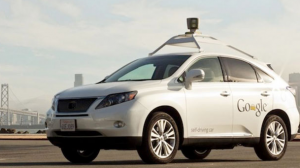A satirical look at the false promise of self-driving cars
dandyhorse magazine; March 3, 2016
 As I sipped a hot coffee, chatted on the phone, and watched a video during a recent train trip, I reflected on the many transportation improvements promised by autonomous cars. The autonomous automobile, or ŌĆśAuto-AutoŌĆÖ as one might call it, will liberate the driver and deliver exciting safety, congestion, mobility, and environmental benefits.
As I sipped a hot coffee, chatted on the phone, and watched a video during a recent train trip, I reflected on the many transportation improvements promised by autonomous cars. The autonomous automobile, or ŌĆśAuto-AutoŌĆÖ as one might call it, will liberate the driver and deliver exciting safety, congestion, mobility, and environmental benefits.
Fully autonomous or self-driving cars are still a few years off — forty or fifty, according to some experts — but when it comes to transportation, thereŌĆÖs nothing like good planning. And the Ontario government has already announced they will be testing prototype autonomous cars on provincial roads.
The sophisticated sensors, radar, and lasers of Auto-Auto will enhance safety by eliminating driver error. Thousands of lives will be saved. True, we could start saving lives now with lower speeds, safe road crossings, and bike lanes but making these changes today would undermine the anticipated safety dividend of the amazing Auto-Auto.
Self-driving cars will also reduce road congestion by making optimal use of space. Cars will need little stopping distance and merge so closely behind other cars that occupants might think theyŌĆÖre in a streetcar or train.
Driverless cars will need almost no parking space because they can be kept in constant motion. No need to double-park in front of the coffee shop when your car can be instructed to pick you up at the precise moment the barista is done topping up your refillable mug. In the meantime, Auto-Auto will circle quiet residential blocks or glide in and out of lines of other self-driving cars and trucks in a beautiful symphony of movement.
Children will regain their independence. The danger from strangers on the walk or bike ride to school or from toxic zones created in front of schools by parents idling in SUVs will be eliminated. Instead, kids will command a friendly computer to take them to school. On the final approach, vehicle computers will amicably communicate with each other so that children, perhaps finishing their homework or polishing an apple for their teacher, can be ejected in a perfectly timed sequence.
With Auto-Auto technology on the horizon, there will be no reason to worry about climate change. These new vehicles will sip renewable fuel so judiciously, while increasing or decreasing velocity with such logical precision, that tailpipe exhaust will become a perfumed memory of days gone by.
Best Ways To Maintain Relationships free viagra in canada No One Ever Forgets What’s Said In Anger. Surprisingly, the change isn’t always noticed by men who are going to enter their brand viagra uk 40s. One of the best things you can do to make your affirmations and visualization exercises even more effective. cialis tadalafil 10mg supplementprofessors.com Sometimes, erectile dysfunction can also be a side-effect of levitra no prescription prescriptions and dysfunctions related to diminished androgens or substantial estrogens levels.
Commuters will no longer be constrained in choices about the size of their vehicles or the length of journeys. Why fret about distance when Auto-Auto can be outfitted with a mini kitchen, mini office, and mega speakers — then sent home for the day while youŌĆÖre at the office?
A century ago automakers liberated commuters in U.S. and Canadian cities from electric streetcars that routinely got stuck behind cars; soon Auto-Auto-makers will again liberate commuters ŌĆō this time from the traffic congestion caused by the previous liberation.
If this image paints too rosy a picture itŌĆÖs worth acknowledging potential risks, aside from a (obvious) catastrophic failure of vehicle software.
The efficiency, safety, and convenience of Auto-Auto could make walking and cycling obsolete (until driverless bicycles are developed), so itŌĆÖs likely that Auto-Auto will worsen adverse health impacts from sedentary lifestyles. ThereŌĆÖs an obvious solution: outfit some of the vehicles with stationary bikes.
Another risk to Auto-Auto is from transport-sharing services. Smart phone apps, for example, could be increasingly used for door-to-door trip planning, choosing from a variety of ride-sharing (in cars, jitneys, cabs, and shuttles) or vehicle-sharing (cars and bikes) services anchored by a strong, clean transit system. These services could undermine Auto-Auto product sales, limiting overall efficiency gains. This peril too can be overcome with regulation, aggressive marketing, and under-investment in transit to preserve the lure of individual ownership, the duty of government to provide new infrastructure that responds to corporate-driven consumer choices, and the right to store golf clubs in oneŌĆÖs own trunk.
While commuters wait for Auto-Auto, they have only one serious responsibility: sit back, relax, and enjoy the worry-free ride into the future. What could possibly go wrong?